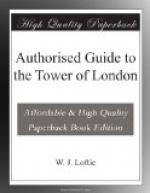the disuse of armour seems to have begun earlier than
on the Continent, but at no time were the ordinary
soldiers covered with metal as seen in Armouries and
other places. The weight, and what was more important,
the cost, prevented such a thing. It was only
the rich who could afford to pay for and had horses
to carry armour, who wore much of what we see now.
Again, armour for war was much lighter and less complete
than that used for the tilt yard, where protection
to the wearer was more considered than his ability
to hurt his opponent. The greater substance of
such armour and its frequent enrichment with engraving
and gilding no doubt led to the preservation of this
class of defence. Chain mail suffered extremely
by rust and neglect, and even plate armour was subject
to the same deterioration. It is consequently
not to be wondered at that little or no armour of a
date previous to the fifteenth century is to be seen
in this collection. On Henry VIII’s death
the first inventory of the Royal collection was made,
and this includes the armour and arms at Greenwich,
and arms and artillery at the Tower of London which,
from the time of Henry VIII, was one of the sights
for foreigners of distinction. In the troubles
of the Civil War the arms were drawn out, and there
is no doubt much, both of arms and armour, was used
and lost. The Protector took one suit, and it
was not till 1660 that the armour, which had meanwhile
been brought to London, was collected, and, with the
weapons still in the store, were formed into a kind
of museum. It is to that period that may be traced
most of the grotesque stories associated with the collection.
At various subsequent periods additions were made
to the collection, and it was arranged in such manner
as suited the knowledge of the day. Series of
figures of kings of England and famous persons were
made and added to or changed on the death of the sovereign.
In later times the whole has been arranged by Sir
Samuel Meyrick. Mr. Hewitt, and Mr. Planche, and
in 1859 Mr. Hewitt drew up the first catalogue of
the contents.
The mounted figures from 1826 till 1883 stood in a
long gallery adjoining the south side of the Tower,
but at the latter date this was pulled down, and the
figures removed to the top floor. Within the last
few years the floor below has been used for the later
arms, but the lighting of the rooms and their shape,
with various other causes, prevent any strictly chronological
arrangements of the collection, many objects of which
also belong to long periods of time.
The arms and armour are now placed on the two upper
floors of the White Tower, the earlier weapons and
all the armour, being on the top floor, while the
later weapons and the Indian arms and armour, with
various personal relics, are placed on what is the
third stage or second floor. To this the visitor
ascends by a circular staircase in the south front
of the Tower. At the foot observe a brass plate
recording the finding in 1674 of the supposed remains
of the “Princes in the Tower,” Edward V
and his brother Richard Duke of York. The visitor
then enters the Chapel of St. John, and on leaving
passes into the smaller of the two rooms on this floor.




